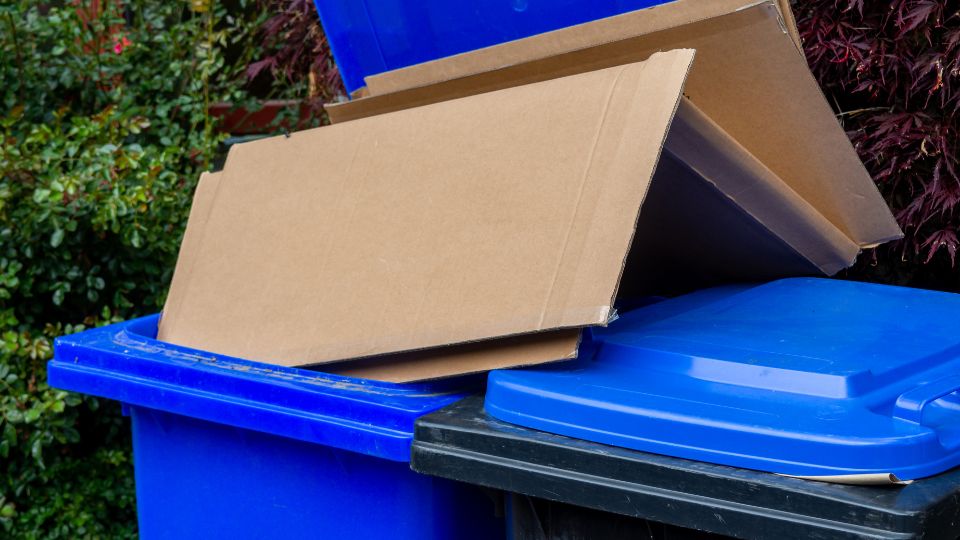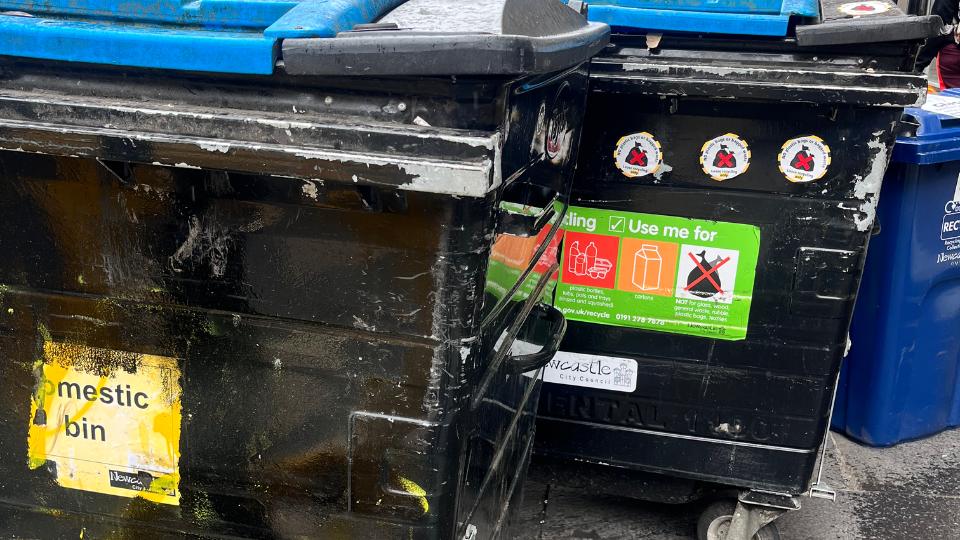
Landfills are a necessary evil in our world today.
They take waste that we cannot reuse or recycle and dispose of it in a (hopefully) safe way. But landfills are not without their problems.
This blog post will explore how landfills work in the UK, what can and cannot be placed in them and the environmental impact they can have.
We will also explore ways that we can all reduce the amount of waste we send to landfills.
Dangers of Landfills
Landfills, while a convenient way to dispose of waste, can cause numerous environmental and health problems.
Here are three dangers of landfills:
Leachate contamination
As waste decomposes in landfills, it produces a toxic liquid called leachate.
This liquid can seep into the soil and groundwater, contaminating drinking water supplies and harming aquatic life.
Landfill gas emissions
Landfills also produce methane gas, a potent greenhouse gas that contributes to climate change.
In addition, landfill gas can escape into the atmosphere and contribute to smog and air pollution.
Health risks for nearby communities
People who live near landfills may be exposed to harmful air pollutants, such as methane and volatile organic compounds (VOCs).
These pollutants can cause respiratory problems, headaches, and other health problems.
Are landfills bad for the environment in the UK?
Landfills in the UK can have negative environmental impacts, but regulations and best practices help mitigate these risks.
Here’s a closer look:
Greenhouse Gas Emissions
Landfills are a significant source of methane, a potent greenhouse gas contributing to climate change.
Methane is produced by the decomposition of organic waste in landfills without oxygen.
However, modern landfill gas capture systems in the UK help reduce methane emissions significantly.
Landfill Leachate
If not properly managed, leachate, the liquid that drains from landfills, can contaminate nearby soil and groundwater.
The UK’s strict landfill liner regulations help prevent this by ensuring leachate is collected and treated before release.
Loss of Valuable Land
Landfills take up significant space, permanently altering the landscape.
The UK government has set ambitious waste reduction targets to reduce reliance on landfills and conserve land resources.
Wildlife and Public Health Risks

Poorly managed landfills can attract pests like rodents and birds, posing health risks.
Additionally, uncontrolled landfill gas emissions can be hazardous if they migrate to nearby homes or buildings.
The UK’s stringent landfill regulations and monitoring programs help address these concerns.
It’s important to note that the environmental impact of landfills in the UK has been considerably reduced compared to the past.
Strict regulations, advanced landfill technologies, and a growing focus on waste reduction and recycling are all contributing factors.
What can be thrown in a landfill in the UK?
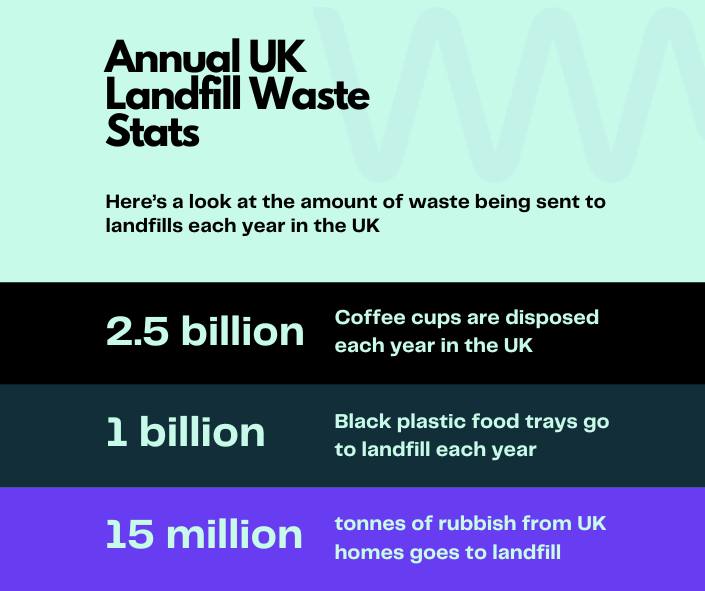
In the UK, landfills are the final destination for waste that cannot be recycled, composted, or reused.
Here’s a breakdown of what typically goes into landfills.
Food waste
This includes meat scraps, vegetable peelings, leftover food, eggshells, and coffee grounds.
While some areas are starting to implement food waste collection programs, it’s not yet universally available.
Plastic
Not all plastics can be recycled in the UK. Typically, plastic bags, cling film, and polystyrene packaging end up in landfills.
Check with your local council for specific guidelines on what plastics are accepted in your kerbside recycling collection.
Nappies and Sanitary Waste
Disposable nappies and sanitary products are not recyclable and go into landfill waste.
Certain types of packaging
While the UK has made great strides in recycling, some composite packaging materials or heavily contaminated food packaging may not be recyclable and end up in landfills.
Here are some resources to help you determine what goes in your landfill bin and what can be recycled or composted:
- Your local council website will have specific guidelines for waste disposal in your area.
- Recycle Now is a useful website with information on waste sorting and recycling across the UK.
Remember, the goal is to reduce landfill waste.
By following these guidelines and prioritising recycling and composting whenever possible, you can help reduce the environmental impact of waste disposal in the UK.
What shouldn’t be thrown in a landfill in the UK?
Landfills in the UK are not suitable for certain types of waste due to safety or environmental concerns.
Here’s what should not go in your landfill bin:
Hazardous waste
This includes items like batteries, used motor oil, paint tins, bleach, and cleaning chemicals.
These materials can leach harmful toxins into the environment if not disposed of properly.
Common examples of hazardous waste include:
- Household cleaners (bleach, drain cleaner)
- Pesticides, herbicides, insecticides
- Oven cleaner, furniture polish, pool chemicals
- All types of batteries (AA, AAA, C, D, 9V, lithium-ion, car batteries)
- Leftover paint, varnish, thinners, paint strippers
- Fluorescent lights and bulbs
- Mercury thermometers
- Old TVs, computers, monitors, mobile phones, and other electronics
- Aerosol cans (even empty ones)
- Laboratory chemicals
- Industrial chemicals (solvents, acids, bases)
- Used oil and antifreeze
- Medical waste (syringes, needles, lancets, expired medications)
- Asbestos
Look for designated collection points for hazardous waste at household waste recycling centres or through special collection events organised by your local council.
Read more on how to dispose of lightbulbs in our dedicated guide.
Electrical waste
Electronic items such as TVs, computers, toasters, and mobile phones contain hazardous materials and should not go in landfills.
The UK has a robust WEEE (Waste Electrical and Electronic Equipment) directive that requires separate collection and recycling of e-waste.
You can return old electronics to designated collection points or to the retailer when you purchase a new item.
Garden waste
Grass clippings, leaves, twigs, and prunings can be composted at home or through council-run composting programs.
Composting not only diverts waste from landfills but also creates nutrient-rich soil for your garden.
Building and demolition waste
This type of waste, including bricks, concrete, plasterboard, and timber, usually requires separate disposal arrangements.
Some recycling centres may accept certain types of construction waste, while others may require taking it to a licensed skip hire company.
By disposing of these items correctly, you can help ensure they are recycled or treated responsibly, limiting environmental risks and promoting resource recovery in the UK.
How do landfills work in the UK?
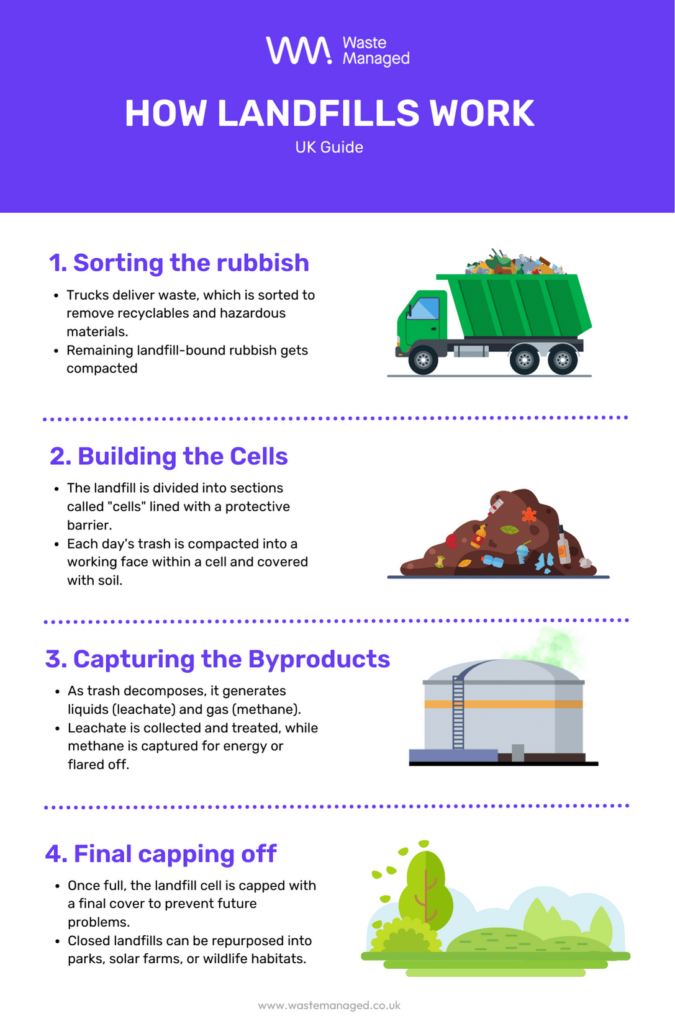
Now we understand what can go into a landfill & what isn’t accepted, we can go over how landfills function and which agencies are involved in these processes.
Landfills in the UK are subject to strict regulations set by the Environment Agency.
Here’s a breakdown of how they operate.
Liners and Leachate Collection
Modern landfills in the UK have a complex base liner system.
This liner acts as a barrier to prevent pollutants from escaping the landfill and contaminating the soil and groundwater.
The liner system typically consists of a combination of clay layers, synthetic membranes, and drainage pipes.
Leachate, the liquid that forms as rainwater percolates through the landfill waste, is collected by these drainage pipes and treated at dedicated facilities to remove contaminants before being released back into the environment.
Waste Compaction and Gas Capture
Waste entering the landfill is compacted by large machines to cut down on air pockets and increase space usage.
This also helps slow down the decomposition process. Landfills in the UK are required to have a gas capture system in place.
As waste decomposes, it produces landfill gas, primarily methane and carbon dioxide. This gas is collected through a network of pipes installed within the landfill and used for various purposes, such as generating electricity or heat.
Daily Cover and Final Capping
At the end of each operating day, the exposed landfill surface is covered with a layer of inert material like soil.
This daily cover helps control odors, prevent windblown litter, and deter pests. Once a landfill reaches its capacity, it’s closed and capped with a final cover system.
This final cover typically consists of several layers, including a clay layer to prevent rainwater infiltration, a drainage layer to manage any remaining leachate, and a topsoil layer to promote vegetation growth.
What are leachate and landfill gas?
As mentioned earlier, leachate and landfill gas are two key byproducts of landfills in the UK:
Leachate

This is the liquid that forms as rainwater filters through decomposing waste in the landfill.
It can contain a complex mixture of dissolved organic matter, inorganic salts, and heavy metals. Leachate contamination of soil and groundwater is a potential environmental hazard.
Landfill Gas

This gas is primarily composed of methane (CH4) and carbon dioxide (CO2), produced by anaerobic decomposition (without oxygen) of organic waste in the landfill.
Methane is a potent greenhouse gas with a much higher warming potential than CO2. Uncontrolled landfill gas emissions contribute to climate change.
Mitigating the Risks
The UK government and Environment Agency have implemented regulations to reduce the environmental impact of leachate and landfill gas:
Landfill Liners
As discussed previously, modern landfills in the UK have a sophisticated liner system at the base and sides.
This liner acts as a barrier, preventing leachate from escaping and contaminating the surrounding environment.
Leachate Collection and Treatment
A network of pipes collects leachate within the landfill.
This leachate is then treated at dedicated wastewater treatment facilities to remove contaminants before being released back into the environment.
Landfill Gas Capture Systems
Landfills in the UK are required to have a gas capture system in place.
This network of pipes collects the landfill gas, primarily methane, which can then be utilised for various purposes:
- Energy Generation: The captured methane can be used to generate electricity or heat in combined heat and power (CHP) plants. This helps reduce reliance on fossil fuels and provides a beneficial use for the captured gas.
- Fuel for Vehicles: In some cases, the captured methane is processed into biomethane, a renewable fuel for vehicles.
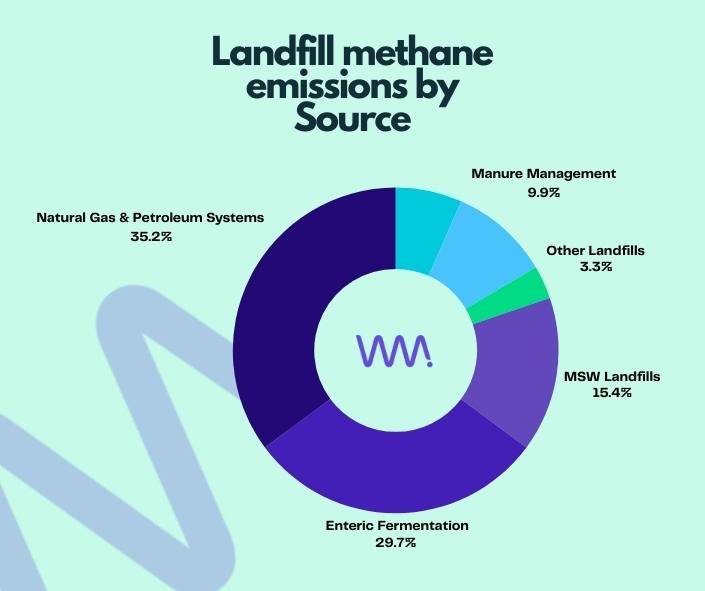
By effectively managing leachate and capturing landfill gas, the UK aims to cut down on the environmental impact of landfills and even generate some renewable energy from this waste source.
How long do landfills last in the UK?
The lifespan of a landfill in the UK depends on several factors:
Landfill Size
Larger landfills with greater capacity will naturally last longer than smaller ones before reaching their limit.
Waste Input Rate
The amount of waste a landfill receives each year significantly impacts its lifespan. Landfills accepting more waste will fill up faster.
Waste Composition
The type of waste disposed of in the landfill also plays a role. Landfills taking in mostly bulky items like furniture will have more void space compared to those filled with dense materials like food scraps.
While it’s difficult to give a definitive answer, most modern landfills in the UK are designed to operate for 20-30 years. However, this timeframe can vary depending on the factors mentioned above.
Extending Landfill Lifespan
The UK government and waste management companies are actively working to extend the lifespan of existing landfills and reduce reliance on them altogether.
Here are some key strategies:
Waste Reduction and Recycling
Encouraging waste reduction and prioritising recycling efforts divert significant waste volumes away from landfills, extending their lifespan.
Increasing Landfill Capacity
Waste compaction techniques and efficient use of space within the landfill can help increase its capacity and extend its operational life.
Exploring Alternative Waste Treatment Technologies
The UK is exploring alternative technologies like advanced waste-to-energy (WtE) plants that can process certain types of non-recyclable waste and generate electricity, further reducing reliance on landfills.
By implementing these strategies, the UK aims to make better use of existing landfill capacity while prioritising waste reduction and exploring alternative waste treatment solutions for a more sustainable future.
What are the alternatives to landfills in the UK?
Landfills are the least preferred option in the UK’s waste management hierarchy.
Here’s a breakdown of the preferred alternatives.
Waste Reduction
The most impactful approach is to reduce waste generation in the first place.
Recycling
Recycling involves processing waste materials into new products. The UK has a well-established recycling infrastructure for various materials like paper, cardboard, plastic, glass, and metal.
By segregating your waste and participating in council recycling programs, you can significantly reduce the amount of waste going to landfills.
Composting
Food scraps and garden waste can be composted, creating nutrient-rich fertiliser for your garden. Many households compost at home, and some local authorities offer community composting programs.
Additional Resources
- The Waste and Resources Action Programme (WRAP) offers a wealth of information on reducing waste at home:
- Your local council website will have specific details on waste collection and recycling programs in your area.
By following these tips and taking a conscious approach to waste management, you can significantly contribute to reducing landfill waste in the UK.
Remember, every small step counts!
How are landfills regulated in the UK?
Landfills in the UK are subject to strict regulations to ensure they operate safely and reduce environmental impact.
Here’s a breakdown of the key regulatory bodies and their roles:
The Environment Agency (EA)
The EA is the main environmental regulator in England.
They set licensing requirements for landfills, ensure compliance with environmental regulations, and monitor landfill operations.
This includes monitoring leachate collection systems, gas capture systems, and landfill stability.
The Scottish Environment Protection Agency (SEPA)
SEPA is the equivalent environmental regulator in Scotland.
They perform similar functions to the EA, issuing permits for landfills and overseeing their operation to reduce environmental risks.
The Welsh Government
Wales has its own government body that regulates landfills. They issue licenses and enforce environmental regulations in wales for landfills operating within Wales.
The Department of Agriculture, Environment and Rural Affairs (DAERA)
DAERA is the Northern Ireland government department responsible for environmental protection, including landfill regulation.
Conclusion
Landfills play a crucial role in the UK’s waste management system, providing a final destination for waste that can’t be recycled or composted.
However, they’re not without their environmental downsides. Leachate contamination, landfill gas emissions, and health risks for nearby communities are all concerns.
The good news is that the UK has implemented strict regulations and best practices to reduce these risks.
We must address waste reduction at the source, diligently recycle what we can, and embrace composting for food scraps and garden waste.
Every business & household has the power to make a difference by taking a conscious approach to waste management.

